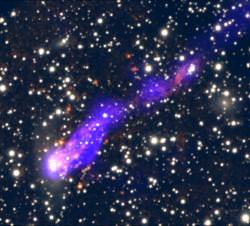Quick, look at the picture with this story. Are you looking at a comet? Nope, that’s an entire galaxy. But the process is similar. In this case, an entire galaxy is plunging into a galaxy cluster. The interstellar winds are tearing away at its structure, shedding material, and trailing stars behind into a trail 200,000 light-years long. But it’s actually a region of creation, not destruction, as millions of new stars are forming behind the galaxy.
The image you’re looking at was captured by NASA’s Chandra X-ray observatory as well as the Southern Astrophysical Research (SOAR) telescope in Chile. The blue colours are regions bright with X-rays, while the red colours show regions rich in hydrogen gas.
The galaxy is called ESO 137-001, and it’s currently falling into the massive galaxy cluster Abell 3627. The pressure from the intergalactic wind coming from the galaxy cluster is causing gas in ESO 137-001 to heat up to millions of degrees. At the same time, though, hydrogen gas is being stripped out of the galaxy and trailing behind for more than 200,000 light years.
From their observations, astronomers can detect that millions of stars are forming in this galactic tail; the interaction between the gas and intergalactic wind is helping it collapse into massive star forming regions.
By galactic standards, these newly forming stars – most are less than 10 million years old – are going to be very lonely. They’re much further away from their galactic home than stars can ever normally form. Life that might evolve on worlds in those regions would see a few stars in the night sky, and a large haze for their parent galaxy, but otherwise, the sky would seem black.
Original Source: Chandra News Release

